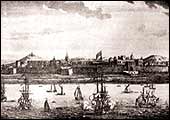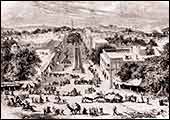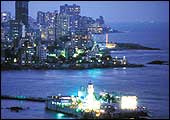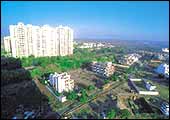|
 Ask
a non-Bengali stranded in Kolkata (non-Bengalis usually feel stranded
in Kolkata) what the city's foremost problem is and the answer you
will likely get: intellectualism. This intellectualism is not merely
a time-pass, it is also a seemingly impregnable defence. Ask
a non-Bengali stranded in Kolkata (non-Bengalis usually feel stranded
in Kolkata) what the city's foremost problem is and the answer you
will likely get: intellectualism. This intellectualism is not merely
a time-pass, it is also a seemingly impregnable defence.
You whine about telephones not working, and
a Kolkatan will talk about the city's three Nobel laureates and
an Oscar winner. You will be given to understand that only those
people who don't come from such a lofty city worry about such a
soulless thing as a telephone. In sharp contrast stands that ode
to restlessness and the capitalist spirit: Singapore. It is not
home to anyone. People come and go, unlike Kolkata, whose addiction
is difficult to shake off for anyone who has lived there for a considerable
length of time. It is also unimaginable that anyone would spin poetry
roaming the manicured streets of Singapore. That happens only in
unkempt Kolkata.
The contrast is not the only connection between
the two cities. Singapore, with ''the highest urban living standard
in the world'', to quote from the memoirs of US Senator Daniel Patrick
Moynihan, was administered from Kolkata, ''necropolis, city of the
dead and dying, vast, putrefying, forsaken,'' for the first 48 years
of its existence. Traces of that are hard to find now. But veteran
journalist Sunanda K. Datta-Ray, in article for Time two years ago,
recalled rejoicing when he stumbled upon a cast-iron manhole cover
in Singapore that bore the old Calcutta's imprimatur. Singapore
lacks gravitas, but not dynamism. It has in abundance a desire to
constantly regenerate itself. Upgrading is as much a way of life
as shopping. Historian Sunil Khilnani calls it a ''geography of
command'', his term for top-down cities, a miracle of method and
management over mood and mystery.
However, while there is much to admire in the
way Singapore works, it probably believes too much that any alteration
to its way of working may lead to a collapse of the system. This
was visible when former Prime Minister P.V. Narasimha Rao, on a
visit to Singapore, said that the answer to the problems of democracy
was more, not less, democracy. His hosts were not amused by the
applause that followed in the audience. Kolkata, on the other hand,
is considered a waste of time by many in India. Stories abound about
how one has to win over a bank clerk through intellectual discussion-perhaps
about Fidel Castro's retirement plans-to have any hope of withdrawing
money within a reasonable period.
Not surprisingly, most of Kolkata's businesses
have moved out. But that is unlikely to bother the intellectual
too much. What is a minute in a millennium? Kolkata is a concept.
It is an ideology, soul, and sensibility. It is not ideas, reason,
or sense. Perhaps the biggest reason for Kolkata's decline has been
too much focus on the abstract at the cost of reality. Singapore's
problem is a complete ignorance of the abstract, which bodes ill
as well.
A touch of Kolkata's gravitas could perhaps
help Singapore believe more in its lasting existence. Kolkata, of
course, has much to learn from Singapore. Perhaps a touch of Singapore's
robust political leadership could translate some of Kolkata's intellectualism
into creativity. It is perhaps time to renew the association.
The Commercial Capitals
Of The Past
 CHENNAI
The change of name from Madras to Chennai in 1996 was nothing
new. Founded as Medraspatnam, its first rechristening was Madrapatnam,
then Maddaraspatan, then Madrazpatnam, then Maddaras and then to
Madras. Some consider Madras the foundation on which modern India
has grown. In the 1640s the city was little more than a small fortified
enclosure. Even then a proper administrative structure existed for
revenue collection and accounts. Other leaders in the town were
the Company's merchants headed by the Chief Merchant. The Company
advanced money to merchants who commissioned the weavers and dyers
brought from Andhra districts to manufacture cloth for the Company's
exports. By the end of the 17th century, Madras had become the chief
British settlement in India and remained so until Calcutta became
the capital in 1774. n CHENNAI
The change of name from Madras to Chennai in 1996 was nothing
new. Founded as Medraspatnam, its first rechristening was Madrapatnam,
then Maddaraspatan, then Madrazpatnam, then Maddaras and then to
Madras. Some consider Madras the foundation on which modern India
has grown. In the 1640s the city was little more than a small fortified
enclosure. Even then a proper administrative structure existed for
revenue collection and accounts. Other leaders in the town were
the Company's merchants headed by the Chief Merchant. The Company
advanced money to merchants who commissioned the weavers and dyers
brought from Andhra districts to manufacture cloth for the Company's
exports. By the end of the 17th century, Madras had become the chief
British settlement in India and remained so until Calcutta became
the capital in 1774. n
 CALCUTTA
The Dutch came first, settling some 25 miles upstream as early as
1653. The French came in 1673, a little way down the river from
the Dutch, then came the Danes further downstream. In the first
half the 18th century, boats began arriving from the Thames to the
Hooghly with droves of writers to keep the East India Company's
accounts and, as subsequent events proved, to manage its businesses
and politics too. By 1742, over 50 vessels were sailing into the
Hooghly each year. Trade in Calcutta had crossed the million-pound
mark annually, and in 1774, the city became the centre of British
operations. The managing agency houses, which are the cornerstone
of Calcutta's growth into an entrepot, came in the early 19th century,
then came the jute and engineering industries. Today, few remember
its halcyon days. CALCUTTA
The Dutch came first, settling some 25 miles upstream as early as
1653. The French came in 1673, a little way down the river from
the Dutch, then came the Danes further downstream. In the first
half the 18th century, boats began arriving from the Thames to the
Hooghly with droves of writers to keep the East India Company's
accounts and, as subsequent events proved, to manage its businesses
and politics too. By 1742, over 50 vessels were sailing into the
Hooghly each year. Trade in Calcutta had crossed the million-pound
mark annually, and in 1774, the city became the centre of British
operations. The managing agency houses, which are the cornerstone
of Calcutta's growth into an entrepot, came in the early 19th century,
then came the jute and engineering industries. Today, few remember
its halcyon days.
 DELHI
The earliest known capital city of Indraprastha was founded by the
Pandavas in 1450 BC. The centre of power, and consequently trade
and commerce, centred around Delhi in the epics. But it shifted
to other areas with the advent of invaders who swept in from the
West. Delhi became the capital of many medieval rulers, attracting
traders and merchants from across Asia. The big change came when
the British built the grand city of New Delhi to symbolise imperial
might and shifted the capital from Calcutta in 1931. Made initially
to cater to a population of 70,000, Delhi saw breathless growth
in the years following independence, when refugees from Pakistan
set up home and scores of small industries. They worked hard and
prospered, but Delhi in modern India never caught up with Mumbai. DELHI
The earliest known capital city of Indraprastha was founded by the
Pandavas in 1450 BC. The centre of power, and consequently trade
and commerce, centred around Delhi in the epics. But it shifted
to other areas with the advent of invaders who swept in from the
West. Delhi became the capital of many medieval rulers, attracting
traders and merchants from across Asia. The big change came when
the British built the grand city of New Delhi to symbolise imperial
might and shifted the capital from Calcutta in 1931. Made initially
to cater to a population of 70,000, Delhi saw breathless growth
in the years following independence, when refugees from Pakistan
set up home and scores of small industries. They worked hard and
prospered, but Delhi in modern India never caught up with Mumbai.
The Commercial Capitals
Of The Present
 MUMBAI
It has always attracted the most promising and successful entrepreneurs
from across the land: Gujaratis, Parsis, Bohris, even street-smart
Malayalees. Little surprise then that it accounts for a third of
the country's Income Tax collections, half of customs, a fifth of
central Excise, and a sixth of value added by the manufacturing
sector. Mumbai banks also account for nearly a fourth of bank credit
in the country and 35 per cent of all cheque clearances. The Reserve
Bank of India and the two biggest stock exchanges of the country
are located here. It is the commerical capital of India by a long
shot, and the city where the best and the brightest flock when they
want to dream big. Not bad for a city that started life as seven
tiny fishing hamlets. MUMBAI
It has always attracted the most promising and successful entrepreneurs
from across the land: Gujaratis, Parsis, Bohris, even street-smart
Malayalees. Little surprise then that it accounts for a third of
the country's Income Tax collections, half of customs, a fifth of
central Excise, and a sixth of value added by the manufacturing
sector. Mumbai banks also account for nearly a fourth of bank credit
in the country and 35 per cent of all cheque clearances. The Reserve
Bank of India and the two biggest stock exchanges of the country
are located here. It is the commerical capital of India by a long
shot, and the city where the best and the brightest flock when they
want to dream big. Not bad for a city that started life as seven
tiny fishing hamlets.
 GURGAON
Delhi has everything that can drive away potential settlers: problems
of power, water, roads, housing, public transport, air pollution,
and law and order. That's because it's a magnet, of course, but
it's gaining the mantle of a professional haven because it's developed
one of India's most prosperous counter-magnets: the suburb of Gurgaon,
only nominally in Haryana. Gurgaon is sylvan suburb, city centre,
and industrial belt, all rolled into one. Private developers have
thrown up row upon row of condos, swank apartments, and exclusive
clubs. Thousands of professionals make their home here, working
in the nearby steel and glass office complexes of multinational
and new economy firms. Delhi's largest shopping malls are coming
up here. Even the old villages have prospered, making fortunes selling
land to the king of suburbs. GURGAON
Delhi has everything that can drive away potential settlers: problems
of power, water, roads, housing, public transport, air pollution,
and law and order. That's because it's a magnet, of course, but
it's gaining the mantle of a professional haven because it's developed
one of India's most prosperous counter-magnets: the suburb of Gurgaon,
only nominally in Haryana. Gurgaon is sylvan suburb, city centre,
and industrial belt, all rolled into one. Private developers have
thrown up row upon row of condos, swank apartments, and exclusive
clubs. Thousands of professionals make their home here, working
in the nearby steel and glass office complexes of multinational
and new economy firms. Delhi's largest shopping malls are coming
up here. Even the old villages have prospered, making fortunes selling
land to the king of suburbs.
 BANGALORE
Its Kannada origins tell us it was called the city of beans. From
its founding days in 1537, it remained sleepy and sylvan-until the
1980s. In two frenetic decades, it's taken over the mantle of the
capital of India's new economy. No other city took advantage of
the liberalisation of 1991 like Bangalore did. In the current year,
Bangalore's software exports are slated to be nearly $2 billion.
That's almost 30 per cent of the country's total software exports.
Since liberalisation, Bangalore's population has almost doubled
to 7.2 million. The city's old landscape of strolling retirees,
gracious bungalows, and roundabouts clad in gladioli are gone. Its
484-sq km spread is now extremely cosmopolitan, attracting diverse
people who take advantage of its still-salubrious climate, cheap
housing, and gentleness. BANGALORE
Its Kannada origins tell us it was called the city of beans. From
its founding days in 1537, it remained sleepy and sylvan-until the
1980s. In two frenetic decades, it's taken over the mantle of the
capital of India's new economy. No other city took advantage of
the liberalisation of 1991 like Bangalore did. In the current year,
Bangalore's software exports are slated to be nearly $2 billion.
That's almost 30 per cent of the country's total software exports.
Since liberalisation, Bangalore's population has almost doubled
to 7.2 million. The city's old landscape of strolling retirees,
gracious bungalows, and roundabouts clad in gladioli are gone. Its
484-sq km spread is now extremely cosmopolitan, attracting diverse
people who take advantage of its still-salubrious climate, cheap
housing, and gentleness.
Return Of The Prodigal
 With
Mumbai (most businessmen still prefer Bombay) occupying the top
rank in the latest annual survey of Best Cities For Business (BT,
December 23, 2001), corporate India has rediscovered the city that
gave it its first and most fertile platform. Since the inception
of BT Best Cities listings, Bangalore alone has always finished
on top, with Mumbai at the second spot. It seemed all along that
Mumbai would never recover it once-central status as the best city
to work in. Bangalore seemed to offer everything that Mumbai did
not: easy housing, law and order, a cosmopolitan ambience, and extremely
amiable weather. It seemed just the right place for the tech companies,
which normally have a lot of international visitors. With
Mumbai (most businessmen still prefer Bombay) occupying the top
rank in the latest annual survey of Best Cities For Business (BT,
December 23, 2001), corporate India has rediscovered the city that
gave it its first and most fertile platform. Since the inception
of BT Best Cities listings, Bangalore alone has always finished
on top, with Mumbai at the second spot. It seemed all along that
Mumbai would never recover it once-central status as the best city
to work in. Bangalore seemed to offer everything that Mumbai did
not: easy housing, law and order, a cosmopolitan ambience, and extremely
amiable weather. It seemed just the right place for the tech companies,
which normally have a lot of international visitors.
Not surprisingly, Bangalore, forever high on
perception, came out tops in the first three surveys, even though
Mumbai was always sniffing down its neck. Perhaps the biggest surprise
of the 2001 survey was Chennai at number two, despite Jayalalithaa's
shenanigans, chronic water shortages, and not the least its sultry
climate. It is, however, strong on infrastructure with its busy
port, the highest teledensity in the country, and hundreds of technical
institutions. It also offers low wages, a high work culture, and
low real-estate prices.
Previously unknown cities have now crept into
the top 10: Mysore, Thiruvananthapuram, an indication perhaps that
even in slovenly calm towns, people see the opportunities outside-and
are unwilling to be left out.
| TOP FIVE BEST CITIES |
|
1994
|
1996
|
1996
|
2001
|
|
BANGALORE
|
BANGALORE
|
BANGALORE
|
MUMBAI
|
|
BOMBAY
|
MUMBAI
|
MUMBAI
|
CHENNAI
|
|
DELHI
|
DELHI
|
HYDERABAD
|
BANGALORE
|
|
PUNE
|
CHENNAI
|
CHANDIGARH
|
CHANDIGARH
|
|
MADRAS
|
PUNE
|
PUNE
|
PUNE
|
|

